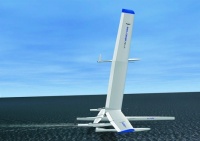The thrilling world of speed-sailing is responsible for some remarkable engineering innovations.
Back in September 2009, L’Hydroptere, a 60ft trimaran that ’flies’ above the surface on two fin-shaped hydrofoils, set a new world record for D-class vessels of 51.36 knots.
More recently, The Engineer reported on the Vestas SailRocket II, a glider-inspired boat with designs on the outright unpowered 500m record of 55.65 knots.
Now, in a bid to push the performance of extreme sailing boats even further, a team of Scottish engineers is using advanced simulation software to design and develop a bizarre-looking vessel that the engineers believe could soon break the near-mythical 60-knot barrier.

Clarke and his team needed to consider many wing-sail design variables. ’Abaqus enabled us to quickly and efficiently visualise the effects of taking different approaches,’ said Clarke. Early in the design cycle, the team created some of the key models within Abaqus first and used the extensive functionality within the software’s interaction module to simplify those models.
Because the wing-sail’s structure and function are so complex, the engineers split the analysis into three stages: the spar, the ribs and secondary structures, and the skin. At each stage, as they built up the structure and added complexity, they wanted to ensure that the wing-sail was acting like a tubular spar with no orientation preference.
For the load case, they chose the worst-case scenario: the wing-sail operating in the horizontal plane and the boat at high speed with minimum keel penetration in the water. This situation generates lift across the entire wing-sail, as well as the greatest bending loads.
The three analyses validated the wing-sail concept and the team is now engaged in extensive computational fluid dynamics (CFD) analyses of the aeroand hydro-dynamics of the boat using FlowVision HPC from Capvidia. ’This process helps us tune the control system and virtually test the boat before it is constructed,’ said Steve Howell, CFD lead on the project.
Once the design is finalised, the V-44 Albatross will be constructed without the benefit of prototypes or wind-tunnel/tow-tank testing. The projected date for the speed-sailing record attempt is early 2013. The chosen site is the upcoming summer Olympics sailing venue in Portland Harbour in the UK.
In depth
Why Europe’s manufacturers are flocking to the cloud
Interest in the cloud is accelerating due to its ability to equip companies of all sizes with vast off-site computing power
Cloud computing – with its ability to drive down costs and drive up productivity and quality – has the potential to deliver extensive benefits for hard-pressed manufacturing companies.
Cloud adoption is accelerating across Europe as large enterprises and small businesses alike become increasingly convinced of the business case for the approach. In a recent study of IT decision makers across Europe, carried out by analyst IDG Research, 87 per cent said that cloud computing was either a critical, high or moderate priority for their organisations over the next 18 months.
The latest evidence suggests that manufacturers are increasingly getting in on the act. In a new survey polling the opinions of CAD users attending Autodesk’s recent series of Digital Prototyping Forums across Europe, 44 per cent of the sample agreed ’our company uses the cloud today because it facilitates data exchange and collaboration internally and with partners, and because it offers virtually unlimited computer power when we need it’.
The cloud is still in its infancy in the design arena. Today we are seeing a revolution not just in attitudes but in the way manufacturers use technology. CAD users and managers are not only looking forward to a future in the cloud, many are using it already.
Current economic conditions appear to be acting as a catalyst for this migration to the cloud, with manufacturing in the eurozone declining for the fifth consecutive month in December. Times are also tough for UK manufacturing. Despite a smaller-than-expected decline during December, the sector is still contracting. To remain competitive, firms must now deliver projects within tight deadlines, putting engineers under increasing pressure to develop innovative products, with the best possible quality at the lowest possible price.
Arguably, the greatest benefit of the cloud to manufacturers is the vast off-site computing power it can command, enabling SMEs particularly to access and exploit computing power previously available only to the largest enterprises.
The cloud also has the potential to dramatically improve on the overall design and creative process through much faster simulation capabilities. In particular, the ability of the cloud to enable engineers to run a large number of FEA analyses simultaneously allows designers to optimise designs in a way that would not realistically be possible without it. The functionality also promotes innovation by supporting the testing multiple design options and creating more sustainable designs and higher-quality products while reducing energy, material and transportation costs.
While it remains to be seen how quickly manufacturers will adopt the technology, the cloud will undoubtedly herald new possibilities for design engineers. And whether it is used to solve tough operating or design challenges, the reach and possibilities undoubtedly now exist to accelerate innovation and drive competitive edge.
Richard Tinsdeall, Autodesk
Design essentials
The key facts to take away from this article
- Abaqus uses a 3D model to analyse the structural strength of components
- It also allows the evaluation and isolation of structures critical to performance
- The team split the analysis into three stages to validate the wing-sail concept
- CFD analyses have helped to tune the control system and virtually test the boat





AI-generated medical responses need monitoring, study finds
This would negate most of the benefit of using AI in the first place, rather like the Locomotive Act 1865 that required any self-propelled road...